Nintendo's Virtual Game Cards: A DRM Dilemma for Switch 2

Nintendo's introduction of Virtual Game Cards for the Switch and the new Switch 2 was meant to simplify the process of managing digital games. The idea was to make loading digital titles as easy as inserting a physical Game Card from one console to the next. However, in practice, these Virtual Game Cards have become a restrictive form of digital rights management (DRM).
One of the major limitations of Virtual Game Cards is that they allow only one copy of a game to exist at any given time. Additionally, local save data can only be stored on one system. This means that if you want to play your Switch 2 games, you need to have your original Switch nearby.
For those with an original Switch, Nintendo offers a system transfer option to the Switch 2. This process converts all your digital games into Virtual Game Cards. However, if you want to play your old games on the original Switch, you need to "eject" the card from the Switch 2 and "load" it on the original Switch. This requires both consoles to be present at the same time, at least during the initial setup.
When the Gizmodo consumer tech team received their Switch 2 unit, they quickly realized the challenges of this system. Nintendo provided them with codes for Mario Kart World, Nintendo Switch 2 Welcome Tour, and a subscription to Nintendo Switch Online + Expansion Pack. However, after spending hours setting up the Switch 2 and downloading the necessary updates and games, they were met with a pop-up window demanding a transfer of game cards from the account owner's original Switch.
In some cases, users may need to resort to a remote transfer through a browser if they don't have immediate access to their older handheld. This option is intended for those with missing or damaged Switch units, but it can result in a factory reset of the original Switch, requiring the user account to be reinstated.
Virtual Game Cards have been available to the original Switch family for a while, and users have already voiced their complaints. The Switch 2, however, highlights these DRM issues even more. Transferring save data from the original Switch to the Switch 2 results in the deletion of data on the older console. Unless files are backed up in cloud saves, users cannot simply switch between systems without downloading the save data first.
Gizmodo's Senior Editor of Consumer Tech, Raymond Wong, experienced this firsthand when he accidentally overrode his Mario Kart 8: Deluxe game save with a new, no-progress one saved in the cloud. This mistake effectively deleted hundreds of hours of effort and vehicle unlocks from both systems. Wong expressed his frustration on social media, questioning why game saves are deleted instead of copied over to another console.
Virtual Game Cards not only complicate the process of playing games on a Switch 2 but also make playing games across multiple Switch systems a time-consuming and restrictive hassle. For instance, Wong transferred several game saves for newly minted Virtual Game Cards from his Switch to his Switch 2, but to play those digital games on his original Switch with his progress, he would need to transfer the game save back from his Switch 2.
Nintendo's Virtual Game Cards were designed to ensure that no more than one copy of a game is tied to any one system. However, this approach restricts users from sharing their games with friends or family. While users can temporarily transfer a game to a friend's account within their "Family Group," this process must be done over local wireless, and the game loan expires after two weeks.
Nintendo's insistence on limiting game ownership to a single copy per system has contributed to the decline of ownership in gaming. Users' save data and games are no longer truly theirs, as they are subject to the restrictions imposed by Virtual Game Cards.